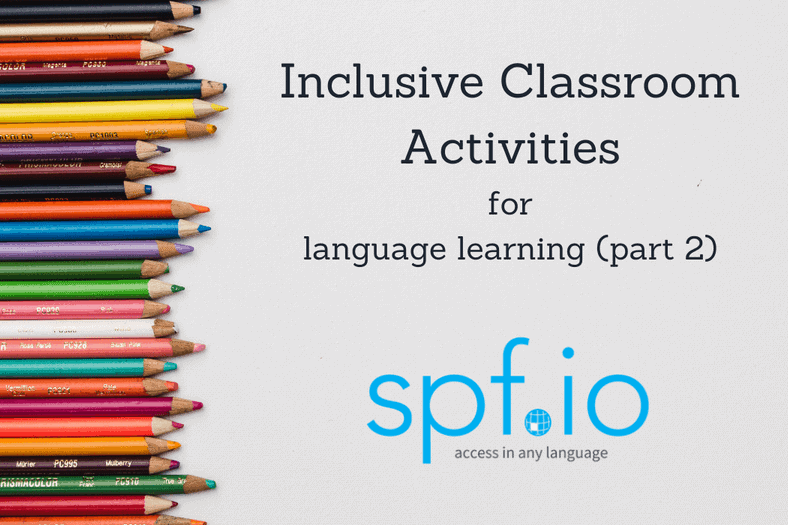Inclusive exercises for language learning (continued)
2. Inclusive language learning strategies: recreate immersion
Language immersion is effective because it requires students to communicate in real-world situations. Ask students to engage in exercises that require active participation and social interactions. Recreate aspects of immersion in the classroom with strategies that also help with language anxiety.
These proven inclusive language learning strategies will help students accelerate their language proficiency:
Group activities: Take pressure off students by having them interact and work in groups to find the correct answers to in-class activities. Cooperative conversational practice also recreates immersive speaking experiences while decreasing anxiety (Horowitz 1995).
Games: Increase learning motivation by asking students to work in teams and rewarding correct answers with points. Students love working together to win at games!
Challenge stereotypical roles: Inclusivity in classrooms is not limited to multilevel exercises. Be intentional about the media you choose – show movies with diverse characters that challenge stereotypes or reflect the makeup of your classroom (ex. choose a movie with a Hispanic doctor as the main character).
Repetition: Good language learning is all about repetition. For example, you can play a captioned movie once before an exercise starts and several more times as students complete a handout. This is a great inclusive classroom example where teachers can give students different activities based on their needs while using the same content. Repetition of media with captions helps students recognize sentence patterns, vocabulary words, and more. Ask students to identify the nouns, verbs, etc., in the movie. Each time you replay the clip, students add to their existing knowledge and feel more successful as they get closer to a complete understanding of the material.
Read-over exercises: Ask students to read captions out loud along with the audio track. This powerful language learning strategy helps them learn a natural speech rhythm as they listen to and copy the speakers’ tones. It is especially useful if the speaking character expresses an emotion – students will naturally mimic their body language, pace, and expressions. You can even record the first time students read the captions out loud, do this exercise, and then re-record your students. There will likely be a significant improvement in the last reading!
3. Choose useful and interesting media
Classroom management becomes much easier when students are interested and excited. Pull on the power of story and choose topics students already like. An example of media you might use in an inclusive classroom is a story set in a familiar cultural setting for your students, like a Taiwanese night market or a scene at a cultural celebration. If students are lower-level readers or newer to the language, try using children’s shows. Find content that helps students with the fundamentals:
Content with sight words (or high-frequency words)
Stories and movies that have parallel sentence structure so students start to recognize language patterns
Movies with repetition: seeing the same word in different contexts helps students build vocabulary
Clips that students might have already seen (like a popular TV show or YouTube channel), or subjects students are familiar with – this helps with language anxiety and gives students a place to start building their language skills. It is especially helpful to choose movies where you can tell what is going on without hearing the audio track.
Tip: Do you have a room full of learners at different levels? You can use the same media with different handouts to challenge students where they are. Offer all students the chance to move on to more advanced handouts if they finish the one at their level. That way, everyone has a way to stay engaged. Use these language learning strategies to make your classroom accessible to diverse learners.
Want an easy way to generate handouts for different levels?
References: Horwitz, E.K. (1995). Student affective reactions and the teaching and learning of foreign languages. International Journal of Educational Research, 23(7), 573-579. Emotional readiness of students.

